
Paul Morrissey is an American film director, known for his early association with Andy Warhol. His most famous films include Flesh, Trash (1970), Heat, Flesh For Frankenstein (1973) and Blood for Dracula (1974), all starring Joe Dallesandro, and the 80’s New York trilogy Forty Deuce (1982), Mixed Blood and Spike of Bensonhurst (1988).
Warhol superstars were a clique of New York City personalities promoted by the pop artist Andy Warhol during the 1960s and early 1970s. These personalities appeared in Warhol's artworks and accompanied him in his social life, epitomizing his dictum, "In the future everyone will be famous for fifteen minutes". Warhol would simply film them, and declare them "superstars".

Jackie Curtis was an American actor, writer, singer, and Warhol superstar.

The Factory was Andy Warhol's studio in New York City, which had four locations between 1963 and 1987. The Factory became famed for its parties in the 1960s. It was the hip hangout spot for artists, musicians, celebrities and Warhol's superstars. The original Factory was often referred to as the Silver Factory. In the studio, Warhol's workers would make silkscreens and lithographs under his direction.

Joseph Angelo D'Allesandro III is an American actor and Warhol superstar. He was a sex symbol of gay subculture in the 1960s and 1970s, and of several American underground films before going mainstream.

Candy Darling was an American transgender actress, best known as a Warhol superstar. She starred in Andy Warhol's films Flesh (1968) and Women in Revolt (1971), and was a muse of the Velvet Underground.
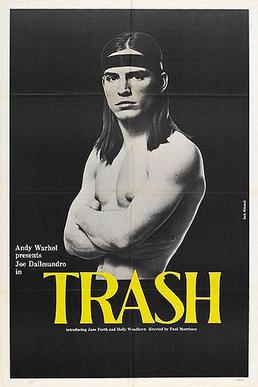
Trash is a 1970 American drama film directed and written by Paul Morrissey and starring Joe Dallesandro, Holly Woodlawn and Jane Forth. Dallesandro had previously starred in several other Andy Warhol/Paul Morrissey films such as The Loves of Ondine, Lonesome Cowboys, San Diego Surf, and Flesh.
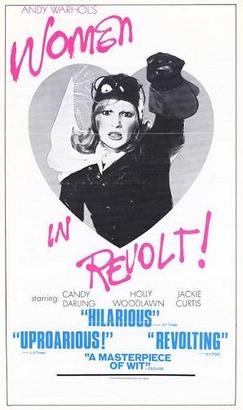
Women in Revolt is a 1971 American satirical film produced by Andy Warhol and directed by Paul Morrissey. It was initially released as Andy Warhol's Women. The film stars Jackie Curtis, Candy Darling, and Holly Woodlawn, three trans women and superstars of Warhol's Factory scene. It also features soundtrack music by John Cale.
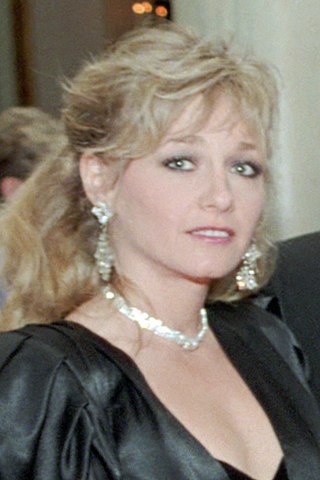
Patricia D'Arbanville is an American actress known for her appearance in Andy Warhol projects.

Lonesome Cowboys is a 1968 American Western film directed by Andy Warhol and written and produced by Paul Morrissey. The film is a satire of Hollywood Westerns, and was initially screened in November 1968 at the San Francisco International Film Festival, where it won the Best Film Award. On May 5, 1969, it was shown for initial viewings at the New Andy Warhol Garrick Theatre in New York City.

Flesh for Frankenstein is a 1973 horror film written and directed by Paul Morrissey. It stars Udo Kier, Joe Dallesandro, Monique van Vooren and Arno Juerging. Interiors were filmed at Cinecittà in Rome by a crew of Italian filmmakers.
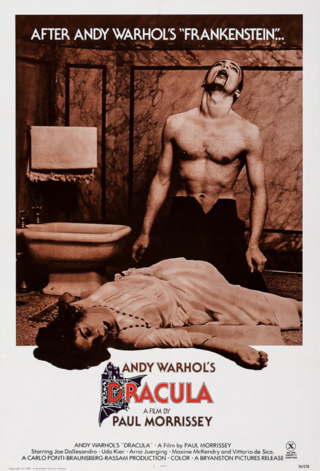
Blood for Dracula is a 1974 horror film written and directed by Paul Morrissey, and starring Udo Kier, Joe Dallesandro, Maxime McKendry, Stefania Casini, Arno Juerging and Vittorio de Sica. Upon its initial 1974 release in West Germany and the United States, Blood for Dracula was released as Andy Warhol's Dracula.
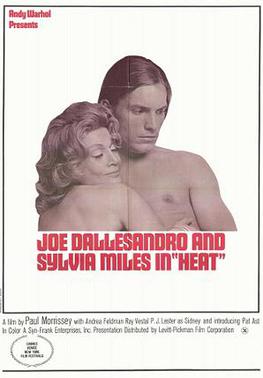
Heat is a 1972 American comedy drama film written and directed by Paul Morrissey, produced by Andy Warhol, and starring Joe Dallesandro, Sylvia Miles and Andrea Feldman. The film was conceived by Warhol as a parody of the 1950 film Sunset Boulevard. It is the final installment of the "Paul Morrissey Trilogy" produced by Warhol, following Flesh (1968) and Trash (1970).

"Lady D'Arbanville" is a song written and recorded by Cat Stevens and released in April 1970. It subsequently appeared on his third album, Mona Bone Jakon, released later that year. It was his first single released after signing a contract with Island Records, with the encouragement of his new producer, Paul Samwell-Smith, fostering a folk rock direction. "Lady D'Arbanville" has a madrigal sound, and was written about Stevens' former girlfriend, Patti D'Arbanville, metaphorically laying her to rest.
San Diego Surf is a 1968 feature film directed by Andy Warhol and Paul Morrissey, and filmed in La Jolla, California in May 1968. On June 3, 1968, Warhol was shot by Valerie Solanas, bringing work on the film to a halt. In 1996, the Andy Warhol Foundation commissioned Morrissey to "finish editing the film based on Warhol's notes".
Geraldine Smith is an American actress.

Pat Ast was an American actress and model. She was best known for starring in Andy Warhol films and being a Halston model and muse in the 1970s.

My Hustler is a 1965 American drama film by Andy Warhol and Chuck Wein. Set on Fire Island, My Hustler depicts competition over the affections of a young male hustler among a straight woman, a former male hustler, and the man who hired the boy’s companionship via a “Dial-A-Hustler” service.

The Garrick Cinema was a 199-seat movie house at 152 Bleecker Street in the Greenwich Village neighborhood of Lower Manhattan in New York City. Andy Warhol debuted many of his notable films in this building in the late 1960s. Frank Zappa and the Mothers of Invention played here nightly for 6 months in 1967.

The 55th Street Playhouse—periodically referred to as the 55th Street Cinema and Europa Theatre—was a 253-seat movie house at 154 West 55th Street, Midtown Manhattan, New York City, that opened on May 20, 1927. Many classic art and foreign-language films, including those by Jean Cocteau, Sergei Eisenstein, Federico Fellini, Abel Gance, Fritz Lang, Josef Von Sternberg and Orson Welles, were featured at the theater. Later, Andy Warhol presented many of his notable films in this building in the late 1960s. Other notable films were also shown at the theater, including Boys in the Sand (1971) and Him (1974).


















